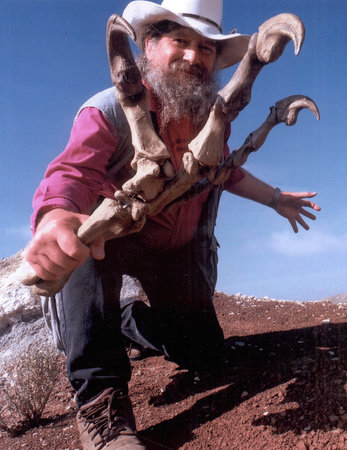Robert T. Bakker

Photo: © courtesy of Dr. Robert T. Bakker
About the Author
“My job is to dig up fossil bones and figure out how dinosaurs lived. I think it’s the best job in the universe.”—Dr. Robert T. Bakker
Dr. Robert T. Bakker is a paleontologist and works with the Wyoming Dinosaur International Society and the author of the children’s books Raptor Pack and Maximum Triceratops.
ABOUT THE AUTHOR
I DIG RAPTORS
I dig raptors. Every week I climb into my truck with a couple of friends and a dog named Pepper and drive to Wyoming to dig Jurassic dinosaurs for two or three days. We specialize in meat-eaters. We’ve excavated the Big Three of Jurassic predators: (1) 36-foot-long allosaurs, who had giant thumb-claws; (2) 30-foot-long ceratosaurs with huge, super-sharp teeth; (3) 40-foot-long megalosaurs, whose jaws carried big, strong, bone-crushing chompers.
And if we dig very carefully, we find small carnivores too. We’ve dug arm bones thinner than a pencil, and tiny nipping teeth from a meat-eater—a raptor—no bigger than a Thanksgiving turkey. Raptors were little but deadly. They were kick-boxers who could dodge and weave and jump. They didn’t kill their prey by biting. They killed by slashing with the knife-shaped claws on their hind feet. And they were smart. X-rays of raptor skulls show a big space for the brain.
Digging tiny bones is harder than excavating giant skeletons. We have to lie down next to the bone layer and stare at the ground while we chip away little bits of rock with X-Acto knives. The fossils are brittle and break into pieces if we hit them too hard. So as soon as we see a tooth or bone we paint it with a special glue that soaks in and holds the fossil together.
This layer of rock with the mini-bones is wonderfully confusing. We’ve got parts from thirty different kinds of Jurassic creatures all mixed together—twenty kinds of dinosaurs, plus crocodiles, ’dactyls, lizard-like reptiles, turtles, and parts of furry mammals. So we make a quarry map. That’s a diagram of where each fossil was dug, so we can figure out which hipbone is connected to which thighbone.
Wyoming wildlife entertains us as we dig. It’s fun watching the eagles and falcons fly over our heads. At sunset we hear coyotes yip and howl. Dinner at the Longhorn Restaurant is homemade pizza and really good soup, followed by chocolate-cream pie (a Wyoming specialty). The cook always asks about what we found.
But the really difficult part begins back at the lab, where we clean the fossils under the microscope. One day of digging usually means ten days of lab work. We take photos through the ’scope and make careful drawings of the fossils enlarged fifty times. Then we consult with other paleontologists. We fax diagrams and send photos by computer. “Ever seen a tooth like this?” we ask. “And how about this neck bone—do you recognize it?”
Sometimes we get stuck. We’ve got bones and teeth dug ten years ago that we still can’t figure out.
When you find nifty fossils, you want to share the discoveries, so we spend a lot of time raising money for museums in Wyoming, where all the fossils we dig will be kept. People ask, “What’s the hardest part of your job?” It’s fundraising. Most folks don’t know that admission fees cover less than half of the cost of keeping a museum going.
But still—it’s the best job in the world. When the bones are cleaned up and set in museum cabinets, each drawer is a window into the Deep Past 140 million years ago. Each box of fossils tells us about our world when it was ruled by dinosaurs, great and small.












